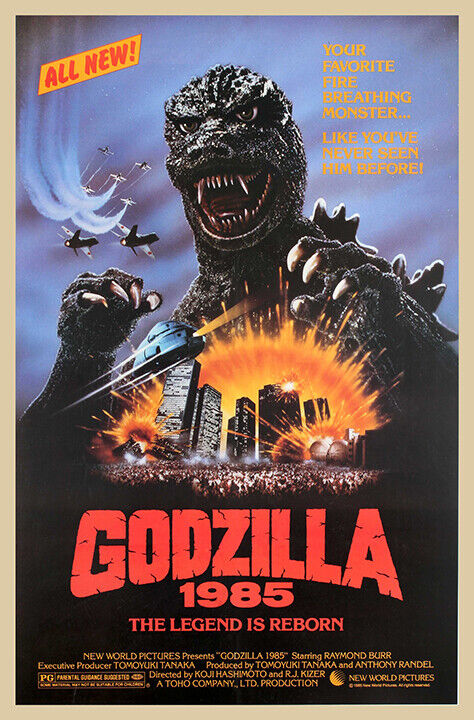Aside from toppling down cities, the Godzilla franchise implements history and social commentary
By SAVANNAH BURGER — arts@theaggie.org
As the longest franchise in movie history boasting 38 films and counting, the Godzilla franchise has been a part of our world for multiple generations. The monster and his film series were originally created by Tomoyuki Tanaka, Ishiro Honda and Eiji Tsuburaya of the Toho Company, Ltd. Godzilla has been everywhere in worldwide pop culture throughout the last few decades, appearing in movies, TV shows, comic books, videogames and countless other forms of media. With the first film of the series, “Godzilla,” released in 1954, this year marks the franchise’s 70th anniversary.
Many forget that the conception of Godzilla came from the conclusion of World War II, when the United States unleashed two atomic bombs over Nagasaki and Hiroshima on August 6 and 9 in 1945. This is where Godzilla was born both in the minds of creators and the canon of the Godzilla franchise.
After the end of the war, America continued with atomic testing in the Pacific, which caused a crew of Japanese fishermen to contract radiation sickness in 1954. This tragedy is referred to as the Lucky Dragon 5 Incident and was hinted at in the first Godzilla movie, especially in the scene of Godzilla attacking a fishing boat. Released two years later, the American version of the film, which was dubbed, “Godzilla, King of the Monsters!” cut all of the scenes related to the incident so as to not paint America in a bad light. Not only this, but they added scenes with Hollywood actor Raymond Burr to attract American viewers.
Godzilla thus is understood to be the product of nuclear waste and radiation contaminating islands off the coast of Japan, morphing him into a larger-than-life, atomic radiation-breathing monster. He is a walking metaphor that represents the terror of the atomic bomb and the pain that the Japanese people suffered in the wake of the American attack.
The biology of Godzilla varies in different versions of the eras of the films. Sometimes, he is a prehistoric marine animal that resided at the bottom of the Pacific Ocean and was disturbed and altered by the Hiroshima and Nagasaki bombings. Other iterations paint Godzilla as a mutated reptile, dinosaur or some sort of amphibian, all being altered by radiation or nuclear bombing in some way.
All 38 films in the franchise belong to one of four eras. These are the Shōwa era (1954 to 1975), Heisei era (1984 to 1995), Millennium era (1999 to 2004) and Reiwa era (2016 to present). Separate from these eras but happening concurrently, there is also the group of American-made Godzilla films.
In the Shōwa era, the first four Godzilla movies portrayed the titular character as an evil force to be stopped, who attacked the innocent civilians of Japan and the friendly monster, Mothra. Following that, the character of Godzilla shifted to be more of a heroic protector. The fight scenes between Godzilla and other monsters are often humorous, and there is little to no continuity between films.
In the Heisei era, however, Godzilla’s character shifts again to be something of a serious anti-hero that provides much more social commentary than the last iterations. Throughout this era’s films, there are comments on world relations, politics, deforestation and oil production. For instance, in “The Return of Godzilla,” (1984) there is an obvious take on the then-ongoing Cold War, as the entire subplot of the movie revolves around nuclear tensions between the U.S. and the Soviet Union, with Japan acting as an intermediary, attempting to protect Godzilla from the two world powers.
Godzilla has also taken jabs at oil production, such as in the 1989 film, “Godzilla vs. Biollante.” The movie starts with scientists attempting to fuse Godzilla’s genetic material with modified plants in the hopes of creating a new source of fertility and plant growth in their barren deserts. All of this effort was directed towards the goal of shutting down oil wells and their monopoly on the economy.
In the last decade, the Godzilla “MonsterVerse” is the first Godzilla series to be made by a company other than Toho. The American film company, Legendary Pictures, is well into its era of Godzilla movies, with four films and an Apple TV series underneath their belt.
Godzilla has always been popular in the United States. In the second half of the 20th century, Toho Company movies were aired every week on national television. This new American-produced line of media, however, has hit viewers with a new wave of Godzilla obsession. The casting of certain popular actors, such as Tom Hiddleston, Millie Bobby Brown, Brie Larson, Kurt Russel and Anna Sawai, have played a big part in MonsterVerse’s success.
70 years later, the famed Godzilla is just as, if not, more popular than he was in his debut in 1954. While he has been increasingly Americanized in some iterations of his character, the Toho Company is still making current films to remind the world of Godzilla’s tragic, atomic conception, as depicted in the 2023 film, “Godzilla Minus One.” Whether he’s on the side of humanity fighting other monsters or plowing his way through Tokyo or San Francisco, Godzilla is showing no sign of losing his status as an all-time pop culture icon.
Written by: Savannah Burger — arts@theaggie.org




